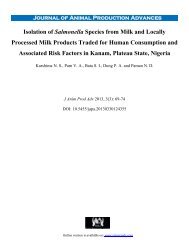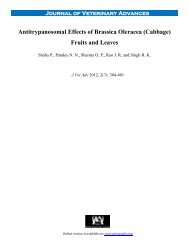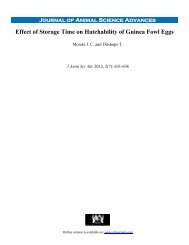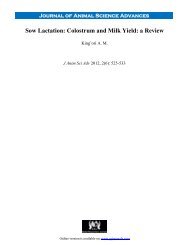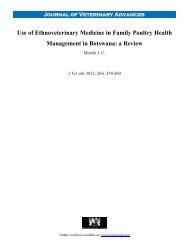PDF Download
PDF Download
PDF Download
Create successful ePaper yourself
Turn your PDF publications into a flip-book with our unique Google optimized e-Paper software.
EFFECT OF GRADED LEVELS OF MEXICAN SUNFLOWER LEAF …<br />
Introduction<br />
Lactation plays an important role in the life of<br />
sheep. Apart from provision of milk for humans,<br />
lactation is an indication of good lamb performance.<br />
Owen (1981) reported that the main difference in<br />
lamb growth arising from lactation is due to<br />
variation in the yield of milk. Poor quality feed<br />
especially during the dry season has been identified<br />
as one of the major constraints to small scale dairy<br />
production (Barje et al., 1999).<br />
In most animals not specialized for milk<br />
production, the composition of milk is, apart from<br />
vitamins, is largely independent of the quality of the<br />
diets, any inadequacy or shortages being reflected<br />
by a diminished yield (McDonald et al., 1987).<br />
Sheep milk composition can also be influenced by<br />
different feeds, grazing systems and by subclinical<br />
mastitic conditions (Bufano et al., 1996). Milk<br />
composition of major and minor components is<br />
affected by feeding regimes, ration components and<br />
forage : grain ratios (Perea et al., 2000). Studies by<br />
Ekeocha et al., 2012 have shown that lactating West<br />
African dwarf ewes fed on Mexican sunflower leaf<br />
meal based diets have substantial mineral profile at<br />
her disposal.<br />
However, research emphasis worldwide has<br />
been on sheep wool and meat production and their<br />
characteristics, not on sheep milk.<br />
Most textbooks on “Milk” deal only with cow<br />
milk, and human milk to some extent (Kon and<br />
Cowie, 1961; Falconer, 1971; Renner, 1982;<br />
Gravert, 1983). The only major sources of research<br />
information on sheep milk appear to be the bulletins<br />
and proceedings of the International Dairy<br />
Federation Seminars held in Greece in 1985 and<br />
1995 (IDF, 1983; 1986; 1996). Not even the 1 st<br />
World Congress of Dairy Products in Human<br />
Health and Nutrition (Serrano Rios, 1994)<br />
recognized the existence or contribution of sheep<br />
milk products to human nutrition, nor does the<br />
handbook of the US Sheep Industry Development<br />
Program (Scott, 1986). In France, the scientific<br />
journal Le Lait devoted an entire issue to goat milk,<br />
including its role as an alternative to cow milk (Le<br />
Lait, 1993). A biobliography on goat milk (Freund,<br />
2000), and the proceedings of a national colloquium<br />
on the nutritional and dietetic qualities of goat milk<br />
(Freund, 1996) have been published, but similar<br />
efforts on sheep milk are still missing. Even a book<br />
on buffalo milk is available (Deepak Sahai, 1996).<br />
Searching the CAB for the past 10 years, the<br />
numbers of publications worldwide on sheep milk,<br />
sheep cheese and allergies related to sheep milk are<br />
minor compared to those on cow milk (King, 1988).<br />
Certainly there are more publications in earlier<br />
years, but those would be based on less<br />
sophisticated analytical methods. Publications on<br />
the nutritional value of sheep milk often give only<br />
gross composition without detailed identification of<br />
more specific unique components of benefit in<br />
human nutrition, although trade magazines contain<br />
many anecdotal reports that are waiting for<br />
scientific evaluation. However, among the 1,000<br />
research projects on sheep worldwide (King, 1988),<br />
less than 4% deal with topics of sheep milk and<br />
sheep dairying.<br />
This experiment is aimed at evaluating feed<br />
intake and weight change from WAD ewes fed<br />
MSLM based diets during lactation.<br />
Materials and Methods<br />
Experimental Site<br />
This study was carried out at the sheep unit of<br />
the University of Ibadan Teaching and Research<br />
farm.<br />
Management of Experimental Animals<br />
Sixteen WAD ewes aged between 16 - 17<br />
months and weighing 19.50 – 22.46kg were used.<br />
The management of experimental animals was same<br />
as for the feeding trial.<br />
Oestrus Synchronisation<br />
Oestrus was artificially synchronized in all the<br />
animals using Dinoprost tromethanine solution<br />
PGF 2 -Tuco products, Canada),<br />
administered intra-muscularly in two doses of 1ml<br />
given 19 days apart. Rams bred at the sheep unit of<br />
Teaching and Research farm were introduced once<br />
signs of heat were detected. Mating was allowed<br />
before 08.00hrs and after 18.00hrs to minimize heat<br />
stress on the rams. All ewes were weighed at mating<br />
and monthly thereafter till parturition and continued<br />
till end of lactation.<br />
728 J. Anim. Sci. Adv., 2012, 2(9):727-733





